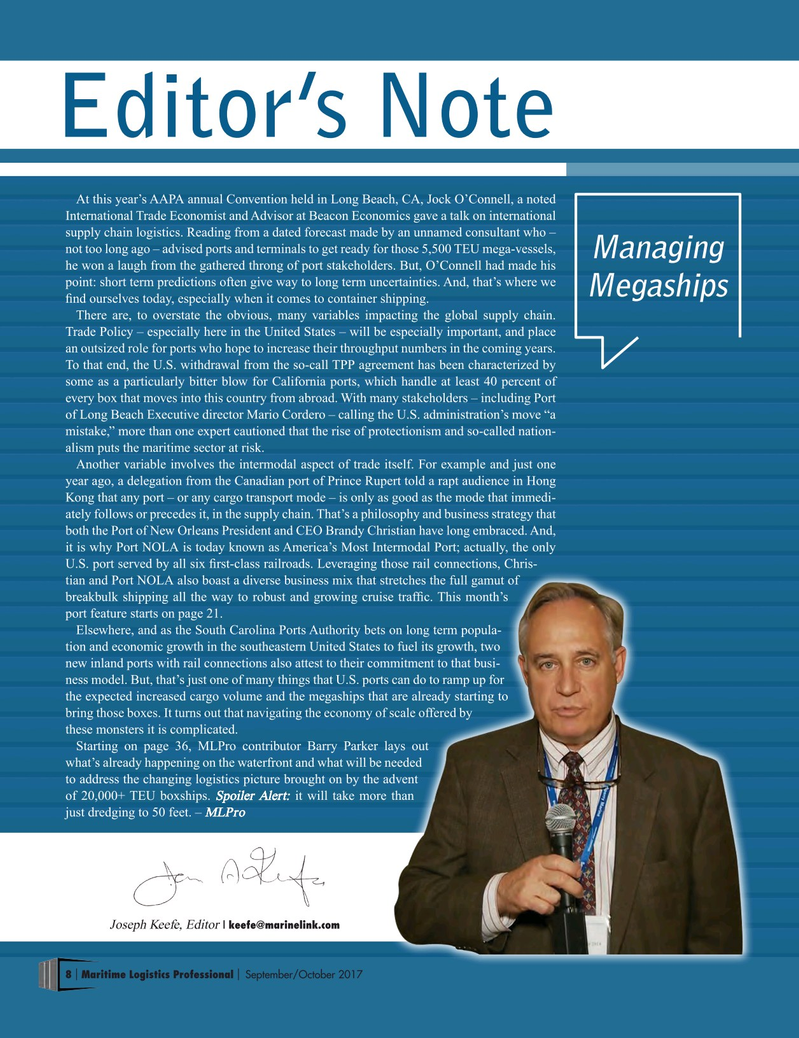
Page 8: of Maritime Logistics Professional Magazine (Sep/Oct 2017)
CONTAINER PORTS
Read this page in Pdf, Flash or Html5 edition of Sep/Oct 2017 Maritime Logistics Professional Magazine
Editor’s Note
At this year’s AAPA annual Convention held in Long Beach, CA, Jock O’Connell, a noted
International Trade Economist and Advisor at Beacon Economics gave a talk on international supply chain logistics. Reading from a dated forecast made by an unnamed consultant who – not too long ago – advised ports and terminals to get ready for those 5,500 TEU mega-vessels,
Managing he won a laugh from the gathered throng of port stakeholders. But, O’Connell had made his point: short term predictions often give way to long term uncertainties. And, that’s where we
Megaships fnd ourselves today, especially when it comes to container shipping.
There are, to overstate the obvious, many variables impacting the global supply chain.
Trade Policy – especially here in the United States – will be especially important, and place an outsized role for ports who hope to increase their throughput numbers in the coming years.
To that end, the U.S. withdrawal from the so-call TPP agreement has been characterized by some as a particularly bitter blow for California ports, which handle at least 40 percent of every box that moves into this country from abroad. With many stakeholders – including Port of Long Beach Executive director Mario Cordero – calling the U.S. administration’s move “a mistake,” more than one expert cautioned that the rise of protectionism and so-called nation- alism puts the maritime sector at risk.
Another variable involves the intermodal aspect of trade itself. For example and just one year ago, a delegation from the Canadian port of Prince Rupert told a rapt audience in Hong
Kong that any port – or any cargo transport mode – is only as good as the mode that immedi- ately follows or precedes it, in the supply chain. That’s a philosophy and business strategy that both the Port of New Orleans President and CEO Brandy Christian have long embraced. And, it is why Port NOLA is today known as America’s Most Intermodal Port; actually, the only
U.S. port served by all six frst-class railroads. Leveraging those rail connections, Chris- tian and Port NOLA also boast a diverse business mix that stretches the full gamut of breakbulk shipping all the way to robust and growing cruise traffc. This month’s port feature starts on page 21.
Elsewhere, and as the South Carolina Ports Authority bets on long term popula- tion and economic growth in the southeastern United States to fuel its growth, two new inland ports with rail connections also attest to their commitment to that busi- ness model. But, that’s just one of many things that U.S. ports can do to ramp up for the expected increased cargo volume and the megaships that are already starting to bring those boxes. It turns out that navigating the economy of scale offered by these monsters it is complicated.
Starting on page 36, MLPro contributor Barry Parker lays out what’s already happening on the waterfront and what will be needed to address the changing logistics picture brought on by the advent of 20,000+ TEU boxships. Spoiler Alert: it will take more than just dredging to 50 feet. – MLPro
Joseph Keefe, Editor | [email protected] 8 Maritime Logistics Professional September/October 2017 | |

 7
7

 9
9
